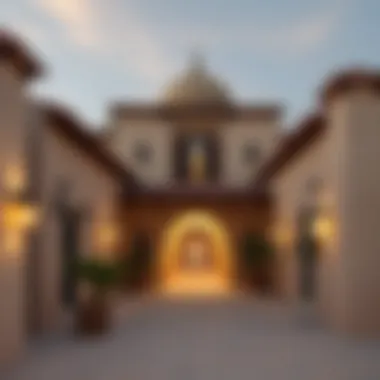Exploring Arabian Villages: History and Modernity


Intro
Arabian villages, with their distinctive charm and historical depth, offer a glimpse into a way of life that is rich and varied. While the glitzy skyline of Dubai often takes center stage in discussions about property and investment, it’s the surrounding villages that tell a different story—a story woven through generations of culture, tradition, and enduring community spirit. To truly grasp the essence of these villages, one must look beyond surface appearances to uncover what makes them unique in today's rapidly evolving real estate landscape.
This article endeavors to uncover the multitude of layers found within Arabian villages, examining their historical significance, architectural marvels, cultural practices, and how they stand in the context of modern-day Dubai's real estate market. By examining current market trends and investment strategies relating to these areas, we aim to provide potential investors and residents with a thorough understanding of what sets these communities apart.
As the saying goes, "To know where you’re going, you must know where you’ve been." This rings particularly true for anyone interested in investing in property within these culturally rich villages. The article not only aims to inform but also seeks to inspire.
Market Trends
The real estate landscape in Arabian villages is evolving, blending traditional elements with contemporary demands. As the investment tide shifts towards these unique communities, understanding the current property trends becomes crucial for anyone looking to dive in.
Current Property Prices
Property prices in Arabian villages can greatly differ from the more urbanized areas of Dubai. On average, the prices can range significantly depending on location, type of property, and community amenities.
- Traditional homes may start as low as 1.2 million AED in some villages.
- Modern builds can go upwards of 5 million AED based on their specific location and luxurious features.
As you move outward from Dubai's core, these villages provide not just a home but an opportunity to invest in a lifestyle rich in history and community.
Upcoming Developments
Several upcoming projects in Arabian villages indicate a blend of investment opportunities that cater to modern buyers while preserving the unique aspects of the villages.
- New housing developments incorporating sustainable living practices will emerge in the coming years.
- Improved infrastructure connecting these villages to urban centers highlights their rising appeal, making commutes shorter and life more convenient.
These developments reflect a thoughtful union of the new with the traditional, ensuring that while the villages expand, they remain anchored in their rich heritage.
Investment Strategies
Understanding the intricacies of investing in such culturally rich locales is essential for potential buyers. By carefully analyzing financing options and risk management techniques, prospective investors can navigate this landscape effectively.
Financing Options
With a variety of financing options available, potential buyers may need to consider several avenues:
- Mortgage plans specifically designed for expatriates.
- Government-backed loans aimed at promoting property ownership among locals.
Each option has its own set of pros and cons, and it’s imperative to conduct thorough research or consult with financial experts to find the best fit for individual circumstances.
Risk Management Tips
Investing in real estate, particularly in regions with a rich history, comes with its unique set of challenges. To mitigate risks, consider the following:
- Thoroughly Research Local Regulations: Understanding the legal framework around property ownership in Arabian villages is key.
- Community Insights: Engage with the local community to understand cultural sensitivities and historical contexts. This can provide valuable insight into the long-term viability of an investment.
- Diversify Investments: Don’t put all your eggs in one basket. Consider a mix of commercial and residential properties to hedge against market fluctuations.
By adopting these strategies, investors can better position themselves, ensuring their venture into the enchanting world of Arabian villages is both rewarding and sustainable.
Investing doesn’t just mean buying properties. It’s about embracing the culture, tradition, and history that shape these communities.
Historical Background of Arabian Villages
Understanding the historical background of Arabian villages is like unearthing a treasure trove of stories, social structures, and architectural wonders. This foundation helps to appreciate how these communities have woven their identities over centuries and how they have adapted to changing times. The villages serve as living museums, reflecting the essence of past traditions while facing contemporary challenges. Exploring this background offers several benefits for real estate agents, investors, homebuyers, renters, and property managers alike, as they seek to engage with a vibrant tapestry of culture and history.
Origins and Evolution
The origins of Arabian villages can be traced back to the very dawn of civilization in the Arabian Peninsula. Initially, these settlements were formed around strategic resources like water and fertile land. As nomadic tribes transitioned into settled communities, they began to engage in agriculture and trade. The evolution over time saw these villages grow into centers of commerce and cultural exchange, linking various parts of Arabia with neighboring regions.
Key characteristics of the evolution of Arabian villages include:
- Adaptation to local climates: Villagers utilized mud-brick or stone to build homes that stood the test of time against the elements.
- Emergence of social hierarchies: As society progressed, leaders emerged, sometimes based on wealth or genealogy.
- Diversification of livelihoods: Initially agriculturally focused, these villages began to incorporate crafts, trade, and even teaching.
These changes did not occur in isolation. Over time, they interacted with diverse influences, including Islamic culture, which brought rich, new dimensions to village life and architecture.
Influence of Geography
The geographical landscape of the Arabian Peninsula has played a monumental role in shaping its villages. The vast deserts, rugged mountains, and coastal areas have each contributed uniquely to how communities developed. For instance, villages near oases thrived on agriculture, while those along the coast turned to fishing and maritime trade. This interplay has shaped the very identity of each village, often reflected in their unique customs and architectural styles.
Some insights to consider regarding geography and its influence include:
- Access to water: Villages sprang up around rivers or oases resulting in social and economic growth.
- Trade routes: Proximity to ancient trade routes fostered cultural exchanges that enriched local customs.
- Topographic challenges: Villages in rugged terrains often had fortified structures for defense, showcasing the need for adaptability and strength.


It’s essential to recognize how geography isn't just a backdrop but a character in the ongoing story of Arabian villages.
Cultural Heritage Preservation
In recent decades, cultural heritage preservation has emerged as a vital area of concern for Arabian villages. As modernization sweeps across the region, the once-dominant local traditions risk being overshadowed. Preservation efforts aim to maintain not only historical architecture but also the practicing of traditional crafts, social gatherings, and localized agriculture. Development projects often spark debates about striking a delicate balance between progress and preservation.
Efforts include:
- Documenting oral traditions: Encouraging elders in the community to share stories and practices that may otherwise fade away.
- Restoration initiatives: Many villages have seen the revival of traditional buildings, giving a glimpse into their architectural past.
- Community involvement: Engaging local residents in preservation projects ensures that the culture remains relevant and alive.
"Preserving cultural heritage in Arabian villages is not merely about safeguarding artifacts; it’s about keeping the spirit of community alive in the face of relentless change."
Through these measures, the essence of Arabian villages continues to transform, remaining in dialogue with both their past and future. This historical backdrop is a critical lens for understanding current trends, including those in the real estate market, as it informs how and why individuals might choose to invest in these remarkable places.
Architectural Characteristics
Understanding the architectural characteristics of Arabian villages is akin to peeling back the layers of history and culture embedded within their very structures. These distinctive features not only reflect the aesthetic values of their time but also address functional needs dictated by the local climate and community life. For investors and property managers, grasping the essence of these architectural traits is key to appreciating the potential of the properties available here.
Traditional Building Materials
The heart of Arabian village architecture rests in its traditional building materials, which seamlessly blend functionality with local aesthetics. Adobe clay, stone, and palm wood are among the primary materials that have withstood the test of time. Adobe, made from sun-dried earth, naturally insulates against the harsh desert heat, creating soothing interiors.
- Adobe: This material is not just efficient; it is also sustainable. The use of readily available natural resources minimizes transport costs and environmental impact.
- Stone: Frequently used in more permanent structures, stone buildings offer durability and resistance against the elements.
- Palm Wood: This lightweight timber is not only functional but also carries a cultural significance, often used in decorative elements and traditional furniture.
Using these materials is not without its challenges. Although they provide aesthetic appeal and practicality, sourcing quality materials in the face of modernization can be tricky. Some villages are pivoting towards alternatives that may compromise authenticity but improve availability and durability.
Design and Layout
The design and layout of Arabian villages often reflect an intricate understanding of communal living and environmental considerations. Traditional layouts typically promote social interaction and shared spaces.
In many villages, homes are built around a central courtyard. This design serves multiple purposes:
- Social Hub: Courtyards function as gathering areas for families, offering a space for socializing and communal events.
- Natural Ventilation: Orienting homes towards the courtyard enhances airflow, a critical factor in regions prone to scorching temperatures.
- Privacy: While promoting community, these designs maintain individual privacy, as the layout often keeps the living spaces shielded from public view.
Moreover, many homes are adorned with intricate mashrabiya screens, which offer shade while allowing for airflow. This balance between spaciousness and intimacy showcases the value placed on community and familial ties.
Sustainability Practices
As modernity encroaches upon these traditional settings, sustainability practices are becoming increasingly vital in preserving the architectural integrity of Arabian villages. Many villages are not only adopting sustainable practices but are thriving because of them.
- Solar Energy: Solar panels are beginning to dot rooftops, harnessing the abundant sunshine to provide clean energy.
- Rainwater Harvesting: Some villages have implemented systems to collect and reuse rainwater, addressing water scarcity while preserving the environment.
- Green Spaces: Community gardens and green trails emerge in certain areas, promoting local ecosystems and biodiversity.
The forward-thinking approach to sustainability in Arabian villages demonstrates a commitment not just to tradition but also to future generations.
Embracing these sustainable practices is essential, particularly for investors who are keen on eco-friendly developments. Properties that prioritize sustainability tend to attract a more discerning customer base, which is crucial in today’s environmentally-conscious market.
Cultural Significance
The core of any community lies in its culture, reflecting the shared identity, beliefs, and traditions of the people. In the context of Arabian villages, cultural significance goes well beyond mere heritage; it embodies the essence of a lifestyle that has persisted through ages of transformation. Understanding this cultural importance can provide insights for real estate agents, investors, and homebuyers alike, allowing them to appreciate the depth of the communities they may engage with.
Festivals and Celebrations
Festivals in Arabian villages are a vibrant tapestry of tradition woven with the threads of communal spirit. Events like Eid al-Fitr and Eid al-Adha are not just religious observances; they are occasions of grand festivities that bring families and friends together. With shared meals, storytelling, and cultural performances, these celebrations reinforce community bonds and maintain the rich cultural fabric.
At such events, one can see the unity of purpose—the older generations imparting stories of their past while children learn the dances and songs that are integral to their identity. The involvement of artisans displaying traditional crafts during these festivals keeps the skills alive, creating a chain between past and future generations.
Social Structures and Community Life
Life in Arabian villages is anchored in strong social structures. Families often live in close proximity, fostering a sense of security and belonging. The kinship plays a significant role, enabling collective problem-solving and mutual support. Decision-making often involves the input of respected elders, illustrating a blend of wisdom and collective participation.
In this light, living arrangements can reflect one’s social standing and obligations to the community. Homes may be built with spaces designed for communal gatherings, underlining social capital's significance. Secluded courtyards and shared resources cultivate neighborly ties, leading to a community where everyone feels invested in one another’s well-being.
"In Arabian villages, it’s not just about the buildings; it’s about the relationships built within them."
Traditional Arts and Crafts
Art is often the very heartbeat of a culture—and in Arabian villages, traditional arts and crafts stand as a testimony to unique heritage. Handcrafted goods such as pottery, textiles, and intricate metalwork showcase not only artistic skill but also cultural narratives. These crafts are often passed from generation to generation, allowing villagers to connect with their ancestral past while expressing their creativity.
Local artisans may host workshops where they teach skills to interested participants, thus ensuring that these crucial fragments of culture do not fade away. For newcomers to the area, participating in these workshops can be a profound way to integrate into community life while supporting local economies.
In many cases, the arts extend beyond functional objects; they embody stories, beliefs, and values of the community, enriching one’s understanding of the Arabian way of life.
In summary, the cultural significance of Arabian villages is multidimensional, fostering social ties, providing opportunities for celebration, and preserving traditional crafts. As such, it is crucial for real estate professionals and potential investors to grasp these facets in order to better engage with these vibrant communities. Understanding the roots and evolution of Arabian village culture allows individuals to appreciate and contribute positively to the rich tapestry of life therein.
Impact of Modernization
The influence of modernization on Arabian villages is an intricate tapestry of change, and understanding this phenomenon is vital for anyone interested in the real estate and cultural dynamics of the region. In recent years, urbanization has elbowed its way into traditional life, prompting a thorough examination of how these developments reshape both the physical environment and the community fabric of these age-old settlements.


Urban Development Trends
As Arabian villages adapt to the pressures of modernization, urban development trends have undergone a significant shift. Where once there were mud-brick homes and communal spaces, new constructions now emerge, often marked by glass facades and modern architectural styles. This juxtaposition of old and new creates a unique skyline that tells the story of progress while echoing the past.
Several driving forces are behind this trend:
- Increased Population Density: With a growing population, the demand for housing intensifies.
- Tourism Growth: Regions rich in cultural significance attract tourists, often leading to infrastructure upgrades, from roads to recreational areas.
- Government Initiatives: Local authorities frequently invest in upgrading village facilities to promote economic self-sufficiency.
While modernization may enhance amenities, there remains a thin line to tread. Preserving the distinct character of these villages while accommodating the needs of contemporary life is a challenge that planners face daily.
Integration with Urban Planning
The integration of Arabian villages into broader urban planning initiatives reveals the intent to strike a balance between tradition and advancement. This approach aims not only to enhance livability but also to ensure that development does not erase the cultural lineage that defines these places.
Key strategies include:
- Zoning Laws: Creating zoning regulations that protect historical sites from being overshadowed by modern constructions.
- Community Involvement: Actively engaging village residents in the planning process to voice their needs and concerns ensures that development reflects the community’s values.
- Infrastructure Improvements: Tactically advancing transport, utilities, and communication technology without overwhelming the traditional aesthetics.
By incorporating these elements, urban planning can foster harmonious growth that respects the essence of Arabian villages.
Changes in Lifestyle and Economy
With modernization, the lifestyle and economic dynamics in Arabian villages are shifting dramatically. No longer solely dependent on agriculture or artisanal trades, many residents now find themselves entangled in a complex economic web that includes tourism, retail, and even tech startups. This evolution presents both opportunities and challenges:
- Employment Options: Diversity in employment allows for better economic resilience.
- Cultural Exchange: Increased interaction with outsiders brings fresh ideas and practices into village life.
However, these changes can lead to cultural erosion if not carefully managed. The embrace of new technologies can create a rift between generations, causing younger residents to seek opportunities in urban centers away from their roots. As properties change hands and new businesses take root, the fundamental characteristics of village life are at risk.
"In times of change, the heart of a village is tested; it is in how we adapt that the essence of our culture survives."
Real Estate Opportunities
When exploring the landscape of Arabian villages, the realm of real estate becomes a critical focal point for various stakeholders. Investors, homebuyers, and renters all find themselves drawn to the unique character and potential of these communities. The vibrancy of village life, paired with market fluctuations, underscores the importance of understanding the intricacies of real estate opportunities in this region.
Investment Potential in Arabian Villages
The investment potential in Arabian villages reflects a blend of traditional charm and modern convenience. Many investors are increasingly recognizing the value of these communities, where cultural heritage is still alive. The affordable property prices compared to urban centers entice many, making it a hotbed for potential growth.
Several factors contribute to this investment appeal:
- Cultural Heritage: Properties often come with historical significance that appeals to both foreign and local buyers.
- Location: Many Arabian villages are strategically located near urban areas, offering both rural tranquility and urban accessibility.
- Tourism Potential: With a growing focus on cultural tourism, properties in these villages can offer promising returns through short-term rentals.
This creates an environment ripe for long-term investments, especially as infrastructure continues to develop and connect these traditional villages more closely with major urban centers.
Purchasing Trends and Insights
As the marketplace shifts, understanding purchasing trends in the Arabian village context gives potential buyers a leg up. The trend shows an increasing number of young professionals and families seeking to escape the hustle of city life, favoring the serene environment of the villages. By doing so, not only do they acquire property, but they also invest in a lifestyle.
Insights from recent market studies suggest:
- Rising Interest from Expats: Expats find the slower pace and community-oriented nature of these villages attractive.
- Desire for Authentic Living: Many buyers prioritize authenticity in their living spaces, opting for traditional architecture and cultural significance.
- Preference for Sustainable Developments: There's a noticeable shift towards homes that emphasize eco-friendliness and sustainability, attracting environmentally-conscious buyers.
Rental Market Dynamics
The dynamics of the rental market in Arabian villages further highlight the opportunities available. With more individuals and families opting for rental properties versus long-term purchases, this sector presents a lucrative avenue for property managers and landlords alike.
Key dynamics to note include:
- Short-Term Rentals: Increased interest from tourists has led to a boom in Airbnb and similar rentals, making it profitable for landlords.
- Long-Term Rentals: Many families are turning to rentals as they transition into these village environments, seeing it as a way to experience village life before fully committing.
- Market Resilience: Despite economic shifts, the rental market in Arabian villages has shown resilience, maintaining steady occupancy rates. This stability makes it an attractive investment area for property owners.
"Real estate in Arabian villages reflects a unique synergy of heritage and modern living, stirring interest from diverse demographics."
Living in Arabian Villages
Living in Arabian villages is not merely about finding a residence; it envelops a lifestyle steeped in tradition, culture, and community. These villages present a unique blend of modern amenities while preserving a way of life that reflects the historical essence of the region. From the breathtaking landscapes to the close-knit relationships formed among residents, the experience of living in Arabian villages is rich and profound.
Community Amenities and Resources
In Arabian villages, community amenities play an integral role, shaping the social fabric and ensuring that the needs of residents are met. Local markets serve as bustling hubs where villagers gather, fostering interactions that go beyond mere commerce. These markets might not boast the glitz of urban shopping malls, but they offer fresh produce, artisanal goods, and a slice of daily life that connects residents to their heritage.
Additionally, families benefit from community centers that provide recreational activities and cultural workshops. These spaces not only promote physical health but also encourage the sharing of local traditions and practices—think pottery sessions, storytelling nights, or Ayallah dance classes. In essence, community amenities here are about nurturing relationships and preserving cultural identities.
Education and Health Services


Quality education and health services are paramount for any village's success. In Arabian villages, schools often emphasize not just academic achievement, but also the teaching of Arabic language, Islamic values, and local history, molding well-rounded individuals who are proud of their heritage. While some villages might rely on smaller educational institutions, partnerships with nearby urban centers often bridge gaps in facilities, providing access to specialized programs and extracurricular activities that enrich the learning experience.
Healthcare services, on the other hand, can vary depending on the village's size and location. While some villages are equipped with basic medical clinics, residents might often depend on mobile health units or make trips into nearby towns for comprehensive care. Telemedicine also plays a growing role, allowing quick consultations without the stress of travel. Thus, while the range of services may be limited, community bonding often tackles these challenges with inventive solutions.
Accessibility and Transportation
Accessibility is a vital aspect of life in Arabian villages, affecting everything from commuting to social interactions. Villagers typically experience a cacophony of roads leading to lush oases, making travel both scenic and functional. However, the maintenance and development of these roads can sometimes lag behind the rapid transformation of urban spaces.
Public transportation options may not always be as extensive as in metropolitan areas, leading many residents to rely on personal vehicles or shared rides. The introduction of rideshare applications has begun to change this landscape, providing more convenient options for those looking to navigate between their homes and the city.
Moreover, cycle paths and pedestrian zones are increasingly being integrated into the village designs, promoting healthier lifestyles while encouraging a slower pace that aligns with the region’s cultural ethos.
Living in Arabian villages offers the duality of old-world charm and modern conveniences, making it an appealing choice for those seeking a balance of tradition and practicality.
As we delve deeper into the essence of Arabian villages, it becomes clear that choosing to live in these communities grants individuals and families a foundation built on cultural richness, community ties, and sustainable living practices. It's not just about making a home; it's about becoming part of a living tapestry woven with thousands of years of shared history.
Challenges Facing Arabian Villages
The challenges Arabian villages face today are multifaceted and deeply intertwined with their rich history and cultural significance. Understanding these elements is crucial for anyone interested in the sustenance and development of these unique communities. As urbanization continues to sweep across the region, it is imperative to not only examine the pressures these villages encounter but also to explore the potential opportunities that arise from these challenges.
Economic Pressures and Opportunities
Economic pressures are palpable in many Arabian villages, pushing against their traditional economic models. Historically, these communities relied on agriculture and local crafts, but shifting economic landscapes have radically altered their foundations. Urban migration is a significant factor—young people are flocking to cities for better jobs, leaving behind an aging population that struggles to maintain local businesses. This scenario raises dire questions about the future profitability of traditional farming and handicrafts in the face of modern market forces.
Yet, within these economic pressures also lie opportunities for revival and growth. For instance, the push towards sustainable tourism has provided locals a chance to monetize their rich cultural heritage. Initiatives that promote local enterprises and celebrate traditional craftsmanship could transform stagnant economies into thriving local businesses. By fostering these new economic avenues, Arabian villages might not only survive but flourish amidst change.
Cultural Erosion Concerns
Cultural erosion is another pressing challenge that threatens the essence of Arabian villages. As dominant urban cultures spread, the unique traditions and languages of these communities face the risk of fading into obscurity.
In many cases, the youth may find themselves caught in a cultural crossfire, valuing modern practices over traditional customs. Events such as communal gatherings and craft fairs, once staples of village life, are now often overshadowed by contemporary preferences. This shift can lead to an homogenization that strips away the individuality of these communities.
To combat this trend, concerted efforts focused on cultural preservation must be prioritized. Initiatives aiming to document local organizations, folklore, and languages help retain the cultural fabric that has woven these villages together. It’s through education and community engagement that the essence of these rich traditions can continue to thrive.
Environmental Sustainability Issues
Environmental sustainability is an urgent issue for Arabian villages as well. Rapid development and population growth have placed considerable strain on natural resources. Water scarcity is a notable concern—many areas have faced severe droughts, affecting agriculture and the overall quality of life.
The impact of climate change further complicates matters, as fluctuating weather patterns can lead to unpredictable harvests and increased costs. Villages must adapt to these challenges while striving to maintain their agricultural practices that have been honed over centuries.
Nonetheless, this issue also invites innovation. Using traditional irrigation methods, alongside modern technology, can create a sustainable model for agriculture. Practices such as rainwater harvesting and organic farming could not only conserve water but also promote healthier ecosystems. By reexamining their environmental practices, Arabian villages can lead the way in sustainable living, showcasing how tradition and modernity can coexist successfully.
The future of Arabian villages hinges on their ability to navigate these challenges effectively, finding balance between preservation and progress.
Through understanding the economic, cultural, and environmental hurdles they face, we can appreciate the intricate tapestry that defines Arabian villages, empowering them as vital components in the broader context of Dubai’s evolving landscape.
For further reading on the economic conditions of Arabian villages, visit Britannica.
To explore cultural preservation efforts, check out Reddit.
If interested in sustainability practices, see resources from environmental organizations.
Future of Arabian Villages
The glance into the future of Arabian villages presents a thoughtful intersection of tradition and modernity. As Dubai continues to expand rapidly, the potential for these villages to adapt to contemporary lifestyles while retaining their unique cultural essence is an area of keen interest for investors, residents, and cultural aficionados. Understanding how these communities evolve in response to urban pressures is essential not only for preserving their heritage but also for ensuring their relevance in the ever-changing landscape of Dubai's real estate market.
Innovative Development Strategies
Innovative development strategies are necessary to breathe new life into Arabian villages without sacrificing their historical narratives. One noteworthy trend is the adoption of eco-friendly building practices, emphasizing sustainability. Developers often choose local materials that align with the architectural heritage of the region, minimizing the carbon footprint.
- Community-driven projects are becoming increasingly popular, where residents and local stakeholders participate in the planning process, ensuring that development meets the needs of the community.
- Incorporating smart technology into traditional settings is also becoming commonplace. For instance, integrating solar panels and energy-efficient systems not only modernizes the lifestyle of villagers but also respects the environment, securing a sustainable future.
- Adaptive reuse of existing structures can also play a significant role in maintaining the character of the village while updating facilities and amenities for current occupants.
Preservation vs. Progress
Striking a balance between preservation and progress remains a pressing challenge for Arabian villages. On one hand, there is a strong desire to maintain the charm and historical integrity of these communities. This often includes protecting traditional crafts, architectural styles, and local customs.
On the other hand, the push for modern amenities and improved infrastructure cannot be ignored. Here are a few key considerations in this ongoing battle:
- Cultural sensitivity in new developments is paramount. Understanding the local customs and incorporating them into any development plan can help minimize resistance from the community.
- Heritage-focused guidelines can provide frameworks for developers, ensuring projects respect the existing culture and continue to tell a story rather than erase it.
- Engagement with local artisans ensures that traditional crafts remain vibrant and that their stories are interwoven with any new developments.
Ultimately, the debate is not about choosing one over the other but merging them in a way that respects both heritage and progress.
Role in Dubai’s Real Estate Market
The role of Arabian villages in Dubai’s real estate market is multifaceted, drawing interest from various sectors. As more investors look toward emerging areas, the charm of these villages can be a major selling point.
- Investor interest in natural landscapes, combined with a rich cultural narrative, attracts buyers seeking more than just property; they crave a lifestyle that is both serene and authentic.
- Short-term rental markets are blooming as tourists seek unique experiences and accommodations that reflect the local culture. Businesses can capitalize on this by converting traditional homes into guest lodgings while ensuring residents benefit from the economic upswing.
- Collaborative ventures with governmental agencies can help to integrate these villages more closely into the wider urban fabric of Dubai. This includes creating public spaces, parks, and facilities that serve both residents and visitors, promoting cultural tourism while enhancing livability.
"The future of Arabian villages lies in their ability to seamlessly blend rich traditions with the flexibility of modern development, ensuring they remain vital components of Dubai’s expanding landscape."







